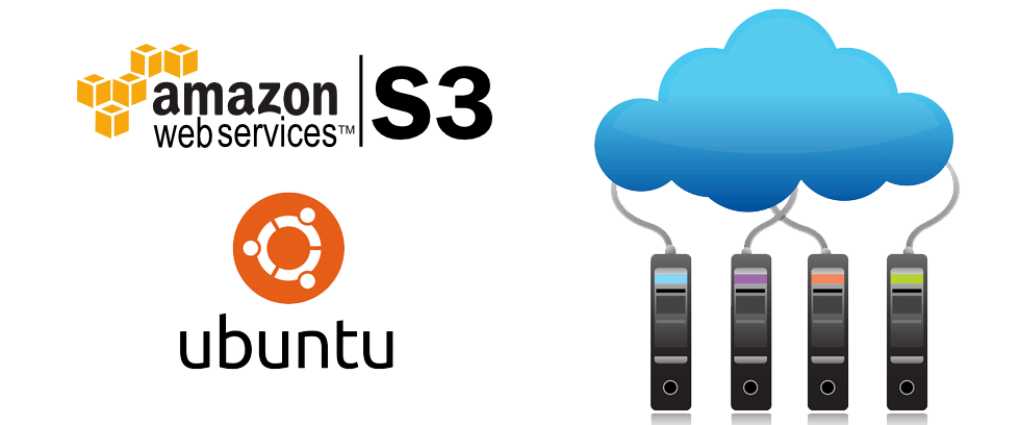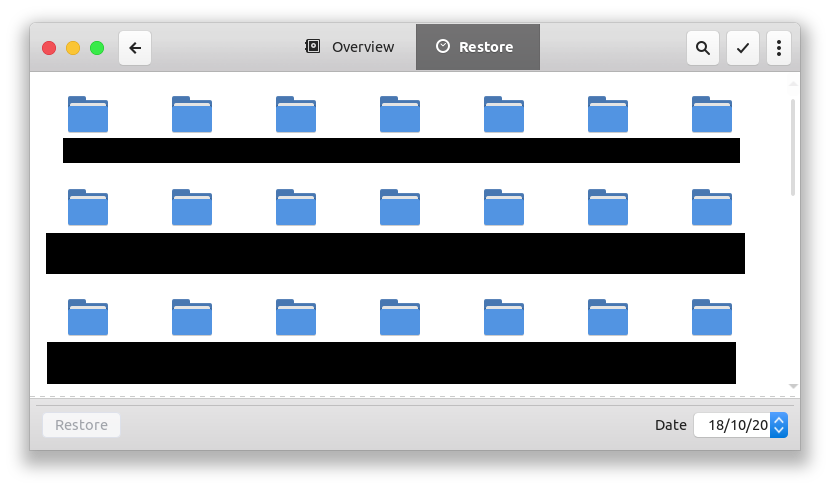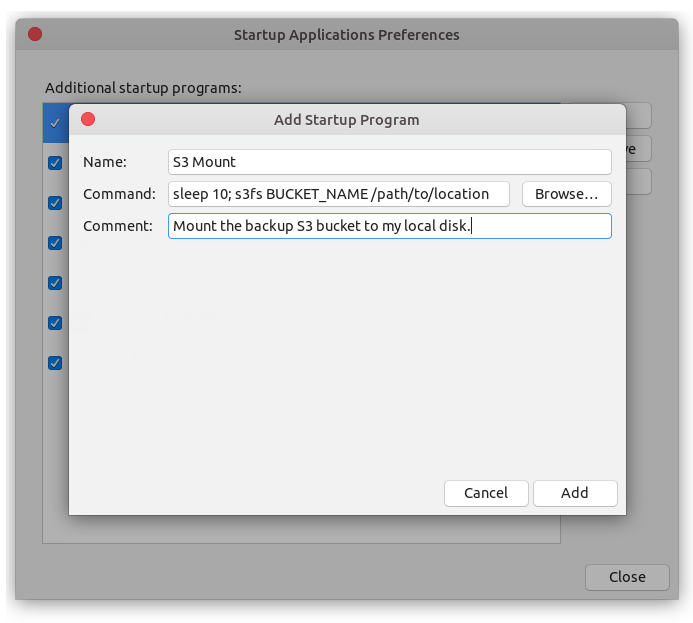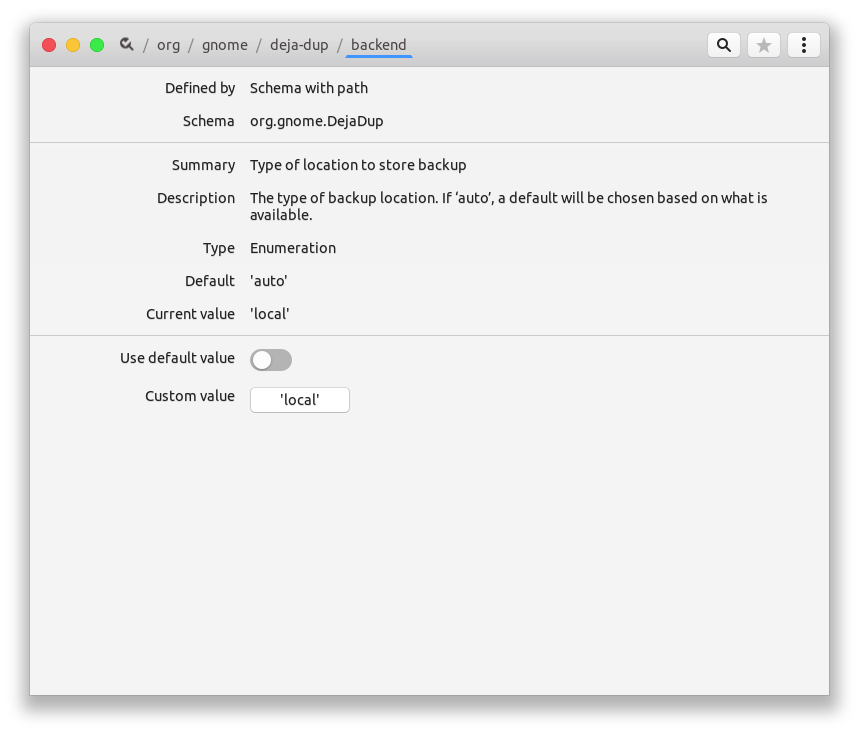- October 18, 2020
- Vasilis Vryniotis
- . 3 Feedback
 DejaDup is the default backup software for Gnome. It’s a GUI for duplicity, focuses on simplicity, helps incremental encrypted backups and up till lately supported a lot of cloud suppliers. Sadly as of model 42.0, all main cloud suppliers have been eliminated. Thus on condition that Ubuntu 20.10 ships with the precise model, any consumer who upgrades and has backups on Amazon S3 gained’t be capable to entry them. On this weblog submit, we are going to present an answer that can let you proceed taking backups on AWS S3 utilizing DejaDup.
DejaDup is the default backup software for Gnome. It’s a GUI for duplicity, focuses on simplicity, helps incremental encrypted backups and up till lately supported a lot of cloud suppliers. Sadly as of model 42.0, all main cloud suppliers have been eliminated. Thus on condition that Ubuntu 20.10 ships with the precise model, any consumer who upgrades and has backups on Amazon S3 gained’t be capable to entry them. On this weblog submit, we are going to present an answer that can let you proceed taking backups on AWS S3 utilizing DejaDup.
The obligatory rant (be happy to skip)
The elimination of the cloud suppliers mustn’t come as a shock. I’m not precisely certain which model of DejaDup deprecated them nevertheless it was across the launch of Ubuntu 17.10 after they have been all hidden as an choice. So for 3 lengthy years, individuals who had backups on Amazon S3, Google Cloud Storage, Openstack Swift, Rackspace and so on may nonetheless use the deprecated function and put together for the inevitable elimination.
So why complain you would possibly ask? Nicely, to begin with, if you replace from an earlier model of Ubuntu to twenty.10, you don’t actually know that the all cloud suppliers are faraway from DejaDup. Therefore if one thing goes mistaken throughout the replace, you gained’t be capable to simply entry your backups and restore your system.
One other huge downside is the shortage of storage choices on the final model of DejaDup. They determined to vary their coverage and assist solely “consumer-targeted cloud providers” however at the moment they solely assist Google Drive. In order that they eradicated all the associated fee environment friendly choices for mass storage and saved just one single very costly choice. I’m probably not certain how that is good for the customers of the appliance. Linux was at all times about having a selection (an excessive amount of of it in lots of instances), so why not keep a number of storage choices to serve each the skilled and inexperienced customers? Fortunately as a result of we’re on Linux, now we have choice to repair this.
Learn how to use Deja Dup v42+ with AWS S3

WARNING: I’ve not examined totally the next setup so use it at your individual threat. If the pc explodes in your face, you lose your information, or your partner takes your youngsters and leaves you, don’t blame me.
Putting in s3fs fuse
With that out of the best way, let’s proceed to the repair. We’ll use s3fs fuse, a program that permits you to mount an S3 bucket by way of FUSE and successfully make it appear to be an area disk. Fortunately you don’t must compile it from supply because it’s on Ubuntu’s repos. To put in it, kind the next in your terminal:
sudo apt set up s3fs
Organising your AWS credentials file
Subsequent, we have to configure your credentials. The s3fs helps two strategies for authentication: an AWS credential file or a customized passwd file. On this tutorial we are going to use the primary technique however if you’re for the latter be happy to view the s3fs documentation on Github. To setup your credentials ensure that the file ~/.aws/credentials comprises your AWS entry id and secret key. It ought to appear to be this:
[default]
aws_access_key_id=YOUR_ACCESS_KEY_ID
aws_secret_access_key=YOUR_SECRET_ACCESS_KEY
Mounting your bucket to your native filesystem
As soon as your have your credentials file you’re able to mount your backup bucket. When you don’t bear in mind the bucket identify you could find it by visiting your AWS account. To mount and unmount the bucket to/from a selected location kind:
# mount
s3fs BUCKET_NAME /path/to/location
# unmount
fusermount -u /path/to/location
Mounting the bucket like that is solely short-term and won’t persist throughout reboots. You may add it on /and so on/fstab however I imagine this solely works with the passwd file. If you wish to use your AWS credentials file a straightforward workaround it to create a shortcut in your Startup Functions Preferences.

Observe that you could add a small 10 sec delay to make sure that the WiFi is linked earlier than you attempt to mount the bucket. Web entry is clearly needed for mounting it efficiently. If you’re behind VPNs or produce other advanced setups, you can too create a bash script that makes the mandatory checks earlier than you execute the mount command.
Configuring DejaDup
With the bucket mounted as an area drive, we will now simply configure DejaDup to make use of it. To start with we have to change the backend to native. This may be carried out both by utilizing a program like dconfig or the console with the next command:
gsettings set org.gnome.DejaDup backend 'native'

Lastly we open DejaDup, go to preferences and level the storage location to the listing that has your S3 backup recordsdata. Be sure you choose the subdirectory that comprises the backup recordsdata; that is usually a subdirectory in your mount level that has identify equal to your pc’s hostname. Final however not least, ensure that the S3 mount listing is excluded from DejaDup! To do that, verify the ignored folders in Preferences.

That’s it! Now go to your restore tab and DejaDup will be capable to learn your earlier backups. You can even take new ones.
Gotchas
There are some things to remember on this setup:
- To start with, you have to be linked on the web if you mount the bucket. If you’re not the bucket gained’t be mounted. So, I counsel you rather than simply calling the mount command, to put in writing a bash script that does the mandatory checks earlier than mounting (web connection is on, firewall permits exterior requests and so on).
- Taking backups like that appears slower than utilizing the previous native S3 assist and it’s prone to generate extra community site visitors (thoughts AWS site visitors prices!). That is anticipated as a result of DejaDup thinks it’s accessing the native file-system, so there is no such thing as a want for aggressive caching or minimization of operations that trigger community site visitors.
- You need to anticipate stability points. As we stated earlier, DejaDup doesn’t realize it writes information over the wire a lot of the functionalities that normally exist in such setups (corresponding to retry-on-fail) are lacking. And clearly if you happen to lose connection halfway of the backup you’ll have to delete it and begin a brand new one to keep away from corrupting your future backups.
- Lastly take into account that this can be a very experimental setup and if you happen to actually wish to have a dependable resolution, you must do your individual analysis and choose one thing that meets your wants.
When you have a advice for an Open-Supply Backup resolution that permits regionally encrypted incremental backups, helps S3 and has a straightforward to make use of UI please depart a remark as I’m more than pleased to present it a strive.

